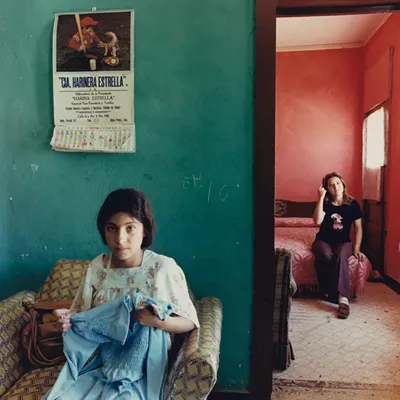Back in the 15th century, Flemish artists were practicing a wholly new form of painting, rendering the subtle landscapes of Northern Europe in glowing colors with muted interplays of light and shadow.
The new painters streamed into Florence, intent on stealing commissions from the Italian Renaissance artists, Andrew Rush writes in his new book, The Nature of Drawing: A Conversation About Art and Community. The Florentines specialized in painting lush bodies and elaborate architecture, and they scoffed at the dull nature work of the intruders.
Except for one artist.
"(T)he great Italian artist Piero della Francesca invited them into his home as his guests," Rush writes, "and used what he learned from them to transform Italian painting with a newly acquired understanding of light and space that no other artist in all of Europe equaled in his time."
His openness to new ideas should be a model not only to aspiring artists, but to all humans who aspire to live a life deeply felt, Rush suggests. "Who knows what 'Flemish artist' might show you the way to be our next Piero if only you invite him into your life?"
The parable of Piero is just one of many elegantly scripted lessons in The Nature of Drawing. Many of the 40 short meditations, each just two or three pages long, were originally published in the newsletter of The Drawing Studio, the art school that Rush founded in Tucson in 1992.
An artist and teacher who turns 80 on Saturday, Sept. 24, Rush has incorporated a lifetime of teaching wisdom into this lavishly illustrated little book.
To go with his points about the life virtues of drawing—Rush argues that the discipline of drawing helps practitioners lead a more-fully engaged life—Rush has reproduced nearly 75 of his own. Made over decades, his drawings include works in pen-and-ink, pencil and watercolor. Some of them are so lovely—the watercolor "Catalinas From the North" comes to mind—that I'm tempted to tear them out and hang them on the wall.
Rush launches the book Friday night, Sept. 23, with a reading, book-signing and birthday party at The Drawing Studio downtown.
Going into its 20th year, the art school now has about 1,000 adult students, says executive director Lynn Fleischman, along with 400 youth students taking TDS art classes at Boys and Girls Clubs and other venues in the community, and 400 seniors studying in retirement homes and neighborhood centers.
For Rush, The Drawing Studio is an extension of the art communities he has sought his whole career.
Born in 1931 in Detroit, where his father was a writer, Rush studied art at the University of Illinois. During his university days, "the comradeship of learning together was such an essential part of what nourished our souls as artists," he writes. After college, though, he found himself isolated and alone, trying to create a body of work on his own. He envied the artist collaborations in the performing arts, and wondered why visual artists didn't replicate the "guild" communities of art school—or of Renaissance studios like Piero's. "Why shouldn't visual artists also have the regular opportunity to share and receive feedback from others who practice?"
Rush set out to create communities where artists could learn from each other. After getting a master's degree in printmaking at the University of Iowa, Rush joined the UA art faculty in 1959. He started a printmaking program, but soon began community studies in printmaking with fellow artists, and the group began "laying the groundwork" for the Rancho Linda Vista art colony in Oracle.
By 1968, the artists had bought an old ranch and moved in, rehabbing cottages and outbuildings into homes and studios. The art experiment, spearheaded by Charles Littler, Bruce McGrew, Rush and others, has survived to this day. Rush still lives and works at the ranch, as do a number of second-generation artists who lived there as children, among them sculptor Selina Littler and actor Maggie Rush.
Rush gave up a tenured teaching post at the UA in 1970 in favor of a more-free-form life, doing his own art while traveling and teaching as a guest printmaker in assorted colleges. (He also undertook "consciousness studies" as a student and teacher.)
At first, he writes, he created The Drawing Studio as a laboratory where he could experiment with his teaching methods. Eventually, though, he realized that students and teachers were staying and studying. It had become a community on its own, for people "who want to be part of a permanent guild for making art as a lifelong process of learning and practice."
Rush formulated a curriculum centered on drawing, to be taught only by practicing professional artists. Some of his regular newsletter essays, now reprinted in the book, give familiar practical advice to beginning artists: Make time in your life for your creative work. Set aside a space to paint. Carry your sketchbook at all times. Look at the world around you.
But embedded into these timeworn dictums are more-profound observations.
Perhaps the busy-ness that keeps us from creative pursuits does not really have that much to do with the laundry that needs washing or the kids who need fetching or the report that needs finishing, Rush suggests. Perhaps those activities turn into a cover for our fear of "being alone in a room with nothing going on but our brain noise."
The artist staring at an empty piece of paper—or the writer wrestling with the blank computer screen, or the scientist pondering the solution to a problem—might try to escape that solitude and silence by jumping back into life's distractions. A disciplined art practice can lead the way back into that zone where we become absorbed in drawing or writing or serious thought, and lose all consciousness of the outside world.
As Rush notes, "The creative state does not resemble the rest of life."
He prescribes a regimen of drawing what is out there in the real world, at first putting aside abstraction and imagination. Those will come later. First, through drawing, artists can "escape the chatter of superficial creativity and step outside ourselves to become a servant of something larger."
The practice of art, he says, can teach us what a privilege it is to be alive.
Reading this book made me want to grab a pencil and a sketchbook and get to work. I might not meet my own personal Flemish artist, but I might begin living a more-sane, more-productive life.










